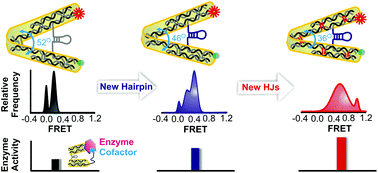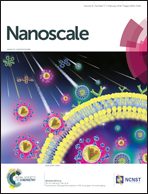Rational design of DNA-actuated enzyme nanoreactors guided by single molecule analysis†
Abstract
The control of enzymatic reactions using nanoscale DNA devices offers a powerful application of DNA nanotechnology uniquely derived from actuation. However, previous characterization of enzymatic reaction rates using bulk biochemical assays reported suboptimal function of DNA devices such as tweezers. To gain mechanistic insight into this deficiency and to identify design rules to improve their function, here we exploit the synergy of single molecule imaging and computational modeling to characterize the three-dimensional structures and catalytic functions of DNA tweezer-actuated nanoreactors. Our analysis revealed two important deficiencies – incomplete closure upon actuation and conformational heterogeneity. Upon rational redesign of the Holliday junctions located at their hinge and arms, we found that the DNA tweezers could be more completely and uniformly closed. A novel single molecule enzyme assay was developed to demonstrate that our design improvements yield significant, independent enhancements in the fraction of active enzyme nanoreactors and their individual substrate turnover frequencies. The sequence-level design strategies explored here may aid more broadly in improving the performance of DNA-based nanodevices including biological and chemical sensors.


 Please wait while we load your content...
Please wait while we load your content...